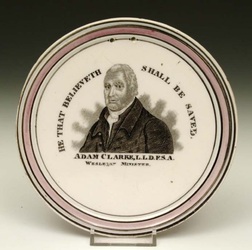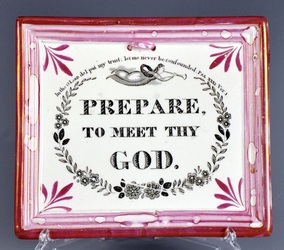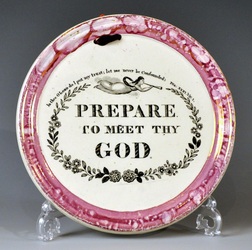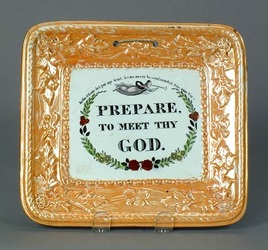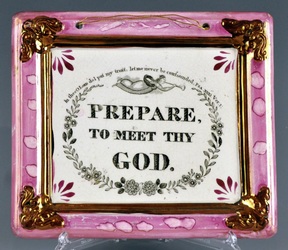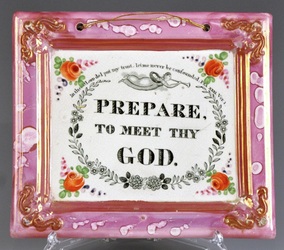|
I've been pretty pleased with the way this attribution has being shaping up... until now. This morning I found a hiccup in my assumptions. Until very recently, I'd never considered that the small rectangular plaques might be attributable to Scott (see my previous blog post on the subject). The brown-edged plaques most commonly associated with Scott are heavily potted, large and clunky (see below left). The smaller rectangular plaques are just the opposite (see below right). Thanks to Shauna Gregg, at Tyne & Wear Archives & Museums, for the photos below of 'Southwick' Wesley and Clarke plaques, from the Sunderland Museum & Winter Gardens, Tyne & Wear Archives & Museums collection. They provide another 'Southwick' connection to a series of very fine and lightly potted circular plaques. As we might expect, these plaques appear with the Charles Wesley verses found on the small rectangular plaques (see images below). But here's what's been bugging me. The 'Southwick' Wesley and Clarke, and the Charles Wesley verses, never appear on the clunky, brown-edged, rectangular plaques most commonly associated with Scott. On its own that doesn't prove anything. Perhaps Scott felt that the nearby Garrison Pottery (Dixon) had cornered the market for large rectangular Wesleys and Clarkes, and decided to differentiate their products by making smaller plaques. This morning I looked for a transfer that might unite the small rectangular plaques with the larger brown-edged ones, but didn't find what I'd expected. The 'Prepare To Meet Thy God' transfers are almost identical. However, look at the verse that runs above the trumpetting angel. On the small rectangular plaque it begins 'In the O Lord ...'. Whereas on the brown-edged plaque it begins 'In thee O Lord...'. The use of 'the' instead of 'thee' appears to be unique to our finer-potted 'Southwick'-attributed group. (Incidentally, this also applies to 'Thou God seest Me' and 'Praise Ye The Lord' plaques, of which there are both 'the' and 'thee' versions.) 'The' appears on finely potted circular plaques (below left) from the same mould as the three circular plaques above. Whereas 'thee' appears on circular plaques from Cornfoot, Colville & Co (Newcastle) (below right). NB despite sharing the word 'thee', the Cornfoot, Colville & Co transfer (detail below left) is NOT the same as that on the clunky brown-edged plaques (detail below right). Note the positioning of the leaves on the sprig. 'The' appears on the two fine wide-bordered plaques below. Note that the 'Southwick' Wesley also appears on plaques like the one below right. 'The' appears on orange-bordered plaques, of both the fine variety (below left) and heavily-potted type with rounded corners (below right). These round-cornered plaques are often attributed to Scott. So the 'the' transfer was in use from c1830 (small rectangular and fine round plaques), right the way through to c1870 (orange-bordered plaques). Whereas the 'thee' transfer was used on clunky brown-edged plaques c1850s–60s. It doesn't seem logical that they were both produced by Scott. Transfer plates were expensive to engrave. Why would one pottery commission two such similar transfers? 'Prepare To Meet Thy God' rarely appears on jugs etc (see lot 418 of the Tolson Collection catalogue for a jug with the Cornfoot, Colville & Co 'Prepare' transfer). Perhaps somewhere there's a Scott-marked jug with a 'Prepare' transfer? P.S.The 'Prepare' transfer, on the clunky brown-edged plaques, appears to match those on the plaques below. It also appears on plaques with the Moore & Co impressed mark. However, as discussed before, the Southwick potteries (Moore and Scott) sometimes shared transfers. P.P.S.Stephen Duckworth has pointed out that the spacing between the word 'thee' and 'O' varies in the plaques above. So it seems even more close examination is required before we can group these into families. On some of the above plaques it almost looks as if an extra 'e' has been squeezed in, to change 'the' into 'thee'. So was the 'Southwick' transfer plate at some point re-engraved with an extra 'e''? A strong argument against this is that 'the' still appears on orange-bordered plaques of the 1870s, which post-date those above.
0 Comments
Leave a Reply. |
AuthorStephen Smith lives in London, and is always happy to hear from other collectors. If you have an interesting collection of plaques, and are based in the UK, he will photograph them for you. Free advice given regarding selling and dispersal of a collection, or to those wishing to start one. Just get in touch... Archives
February 2022
AcknowledgementsThis website is indebted to collectors, dealers and enthusiasts who have shared their knowledge or photos. In particular: Ian Holmes, Stephen Duckworth, Dick Henrywood, Norman Lowe, Keith Lovell, Donald H Ryan, Harold Crowder, Jack and Joyce Cockerill, Myrna Schkolne, Elinor Penna, Ian Sharp, Shauna Gregg at the Sunderland Museum, Keith Bell, Martyn Edgell, and Liz Denton.
|



